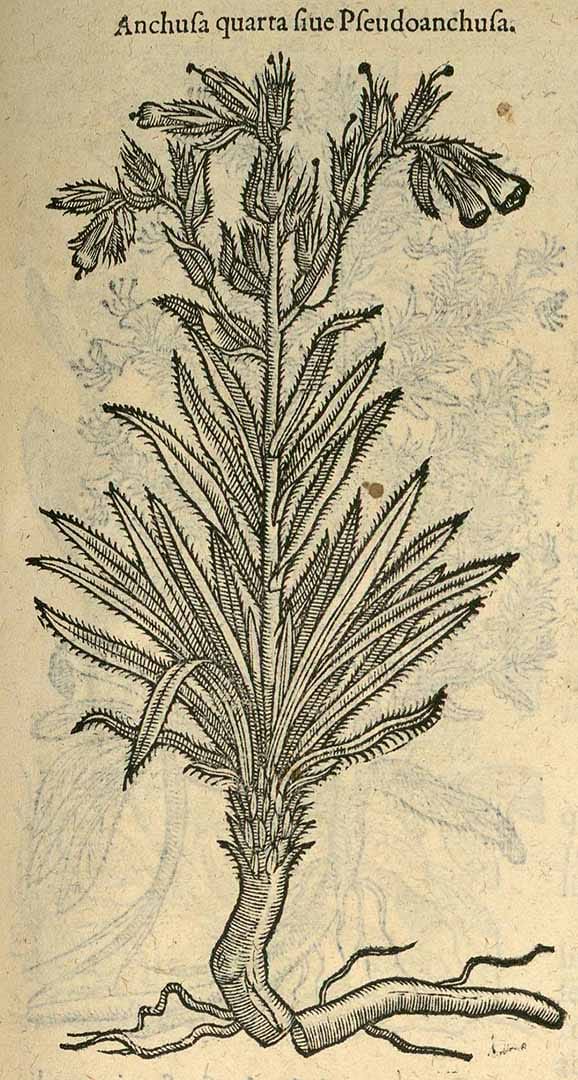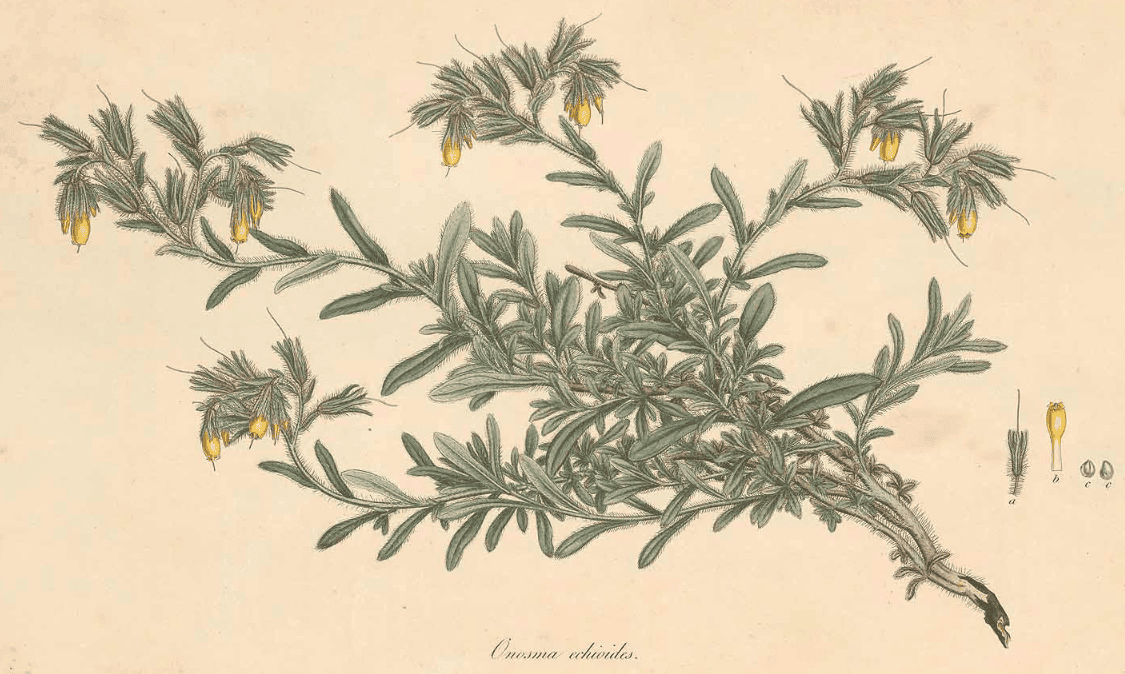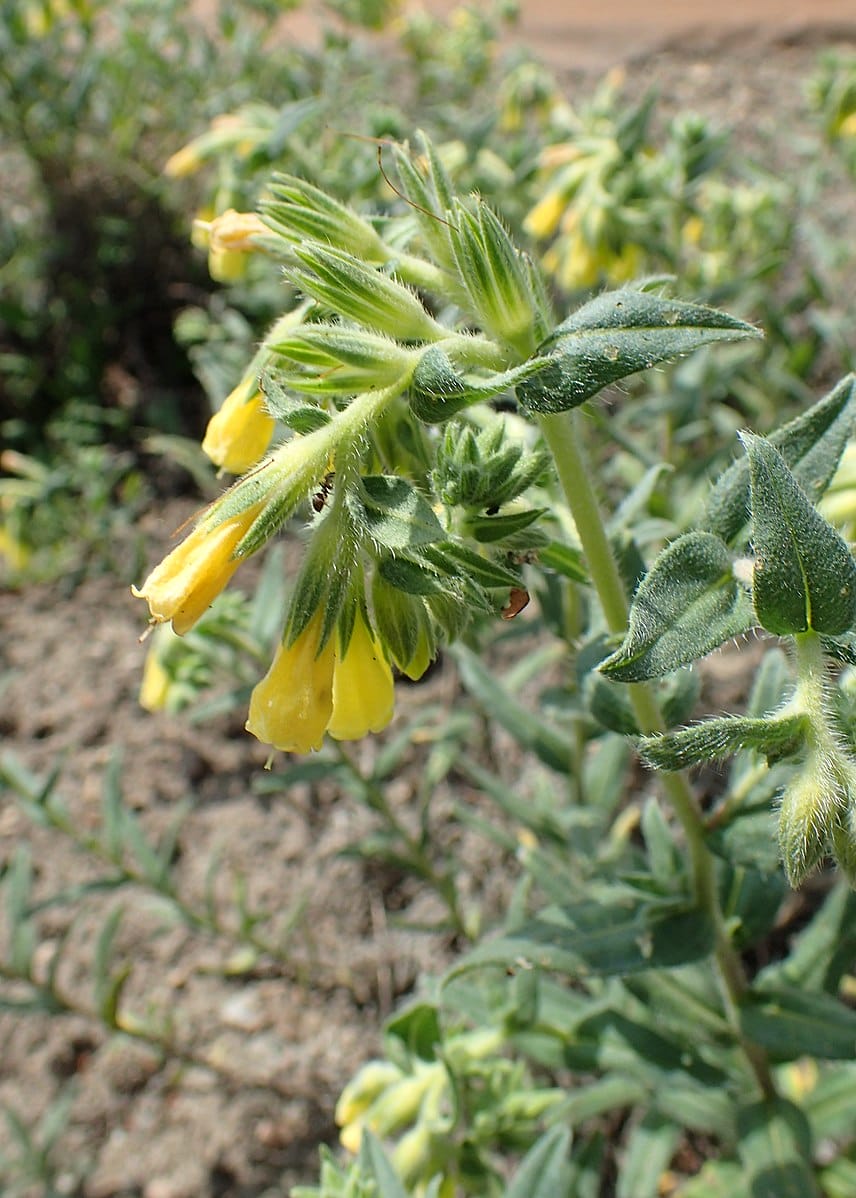Onosma, Bri mog, Ratanjot
Onosma hookeri, O. multiramosum, O. echioides: Bri mog འབྲི་མོག་ (Tibetan)Onosma echioides, O. hispidum: Ratanjot (Unani)
Onosma echioides; Anchusa ex albido flora (Clusius), Pseudoanchusa
O. hookeri: Xi Hua Dian Zi Cao (TCM); Bri mog mchog འབྲི་མོག་ མཆོག་ (Tibetan)
O. hispidum: Cu Ying Mao Dian Zi Cao (TCM)
O. paniculatum: Dian Zi Cao (TCM
 Onosma echioides
Onosma echioidesR. Dodonaeus [Dodoens], Stirpium historiae pemptades sex, 1583
 Onosma echioides
Onosma echioidesSibthrop, J., Smith, J.E., Flora Graeca, 1813
 Onosma echioides
Onosma echioides(Photo by Kenraiz) (Wikimedia)
Botanical name:
Onosma spp.
Onosma hookeri, O. multiramosum, O. echioides (syn. Anchusa echioides, Cerinthe echioides), O. hispidum (Ratanjot, Unani), O. paniculatum
Parts used:
Root, root-bark
Temperature & Taste:
Cool in Tibetan and TCM (Warm in Unani), dry; Sweet, Bitter, Pungent
“According to Galen its temperament is Hot and Dry while some other physicians hold an opposite opinion”. (Avicenna)
Uses:
1. Clears Heat, Stops Cough: (Tibetan, TCM)
-Cough, Bronchitis, Dyspnoea, Asthma from heat (Tibetan)
–Hemoptysis
-Pneumonia (TCM, Tibetan)
2. Clears Blood Heat, Stops Bleeding: (Unani, Tibetan, TCM)
–Hemoptysis, vomiting of Blood from Blood heat
-Measles, Papular rashes
-decoction with Hydromel for Chronic Fever (Avicenna)
-Bilious Eruptions, Eczema, red Rashes and Swellings from Blood heat
-Uterine pain
-painful Hard Swellings
-prevents proliferation of impure blood (Tibet)
-more recently for Hypertension
3. Clears Damp, Opens Obstructions: (Unani)
-stranguria with turbid urine (TCM)
-kidney and bladder obstructions, Stones
–Jaundice; pain and swelling of the Liver or Spleen or Kidney
-“Its decoction with hydromel is useful in Jaundice and Splenalgia”. (Avicenna)
4. Externally:
–chronic ulcer, ulcerating sores (Unani, TCM)
-burns, scalds (TCM, Unani)
-“It is applied with wax and olive oil on wound. especially on the burn Wounds”. (Avicenna)
–with vinegar to vitiligo, leucoderma, psoriasis, warts, herpes, carbuncles
-“When painted with vinegar, it cures Pityriasis”. (Avicenna)
-“It dissolves scrofula when applied with fat”. (Avicenna)
–root fried in oil is applied to Alopecia
-as a suppository to cleanse afterbirth
-“A pessary made from its roots induces abortion”. (Avicenna)
The Flowers are regarded as cardiac and stimulant, used in rheumatism and palpitations
Dose:
3–5 grams
Corrective:
Oil of Violet (Unani)
Substitutes:
1. Sapphireberry (Symplocos Zhu mkhan) is often used as a substitute in Tibetan Medicine.
2. Indusyunic states that O. bracteatum and O. hookeri are used as substitutes for O. echiodes and O. hispidum
3. Camomile (Unani)
4. This is called Tibetan Gromwell. The Chinese Gromwell (Lithospermum spp.) can also be used. The latter is known as Zi Cao in TCM, while the Tibetan Gromwell is called Xi Hua Dian Zi Cao (ie. a variety of ‘Zi Cao’). Lithospermum Zi Cao can be used.
Main Combinations:
1. Onosma Bri Mog with Madder and Lacca for Heat in the Blood, Lung Heat, Kidney Heat. These three medicines are often combined and are called Tshos gsum in Tibetan Medicine.
2. Heat in the Blood Onosma with Emblic Myrobalan, Elecampane, Tabasheer, Calcite, Licorice (as in Subduer of All Blood Disorders)
3. Kidney Stones, the decoction with Hydromel. (Avicenna)
Major Formulas:
Subduer of All Blood Disorders (Khrag khrugs kun sel) (Tibetan)
Blood Medicine 7 (Khrag sman bdun pa)
Emblic 25 (Skyu ru nyer lnga) (Tibetan)
Onosma 7 (Rgwa glo’i sman dmar) (Tibetan)
Amomum 19 (Ko la 19) (Tibetan)
Sandalwood 18 (Tibetan)
Cautions:
Species of Onosma contain potentially toxic alkaloids. Overdose and long-term use should be avoided
